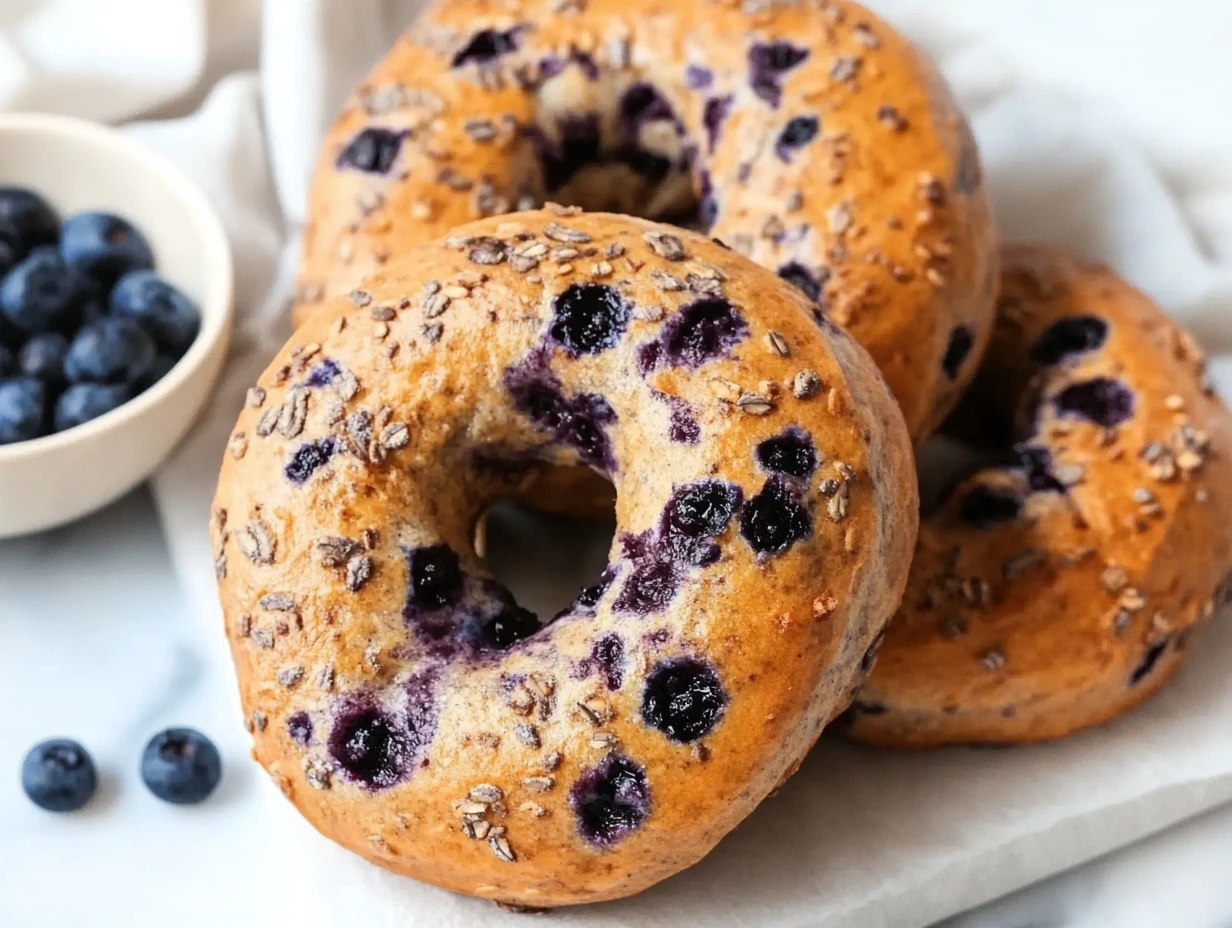Blueberry Bagels, a beloved staple in many households, are known for their chewy texture and unique flavor profile. When infused with blueberries, they transform into a delightful treat that combines the tangy sweetness of fruit with the satisfying heartiness of bread. Homemade blueberry bagels take this classic favorite to the next level, offering unparalleled freshness, flavor, and the opportunity for customization. Whether you enjoy them toasted with a smear of cream cheese or plain as a grab-and-go snack, making blueberry bagels at home ensures a delicious and personalized experience.
Table of Contents
What Are Bagels?
Brief History and Explanation of Bagels
Bagels are round bread with a hole in the center, characterized by their dense, chewy interior and slightly crisp exterior. This unique texture is achieved by boiling the dough before baking it. Originating in Eastern Europe, bagels were a staple of Jewish cuisine and were popularized in the United States by immigrant communities in the early 20th century. Today, bagels are enjoyed worldwide in various flavors and styles, from savory to sweet, with blueberry bagels being a modern, fruity twist on the classic recipe.
Why Make Blueberry Bagels at Home?
Benefits of Homemade Bagels
While store-bought bagels are convenient, crafting your own blueberry bagels at home provides several advantages that elevate both taste and quality.
Freshness
The Advantage of Using Fresh Ingredients
Homemade blueberry bagels allow you to use the freshest ingredients, including ripe, juicy blueberries that enhance the bagel’s flavor. Fresh ingredients not only improve taste but also ensure that your bagels are free from preservatives or artificial additives. The result is a wholesome treat that’s as nourishing as it is delicious.
Customization
Adjusting Sweetness and Flavor
One of the joys of making bagels at home is the ability to tailor them to your preferences. You can adjust the sweetness by adding more or fewer blueberries, incorporate other flavors like lemon zest or cinnamon, and even experiment with different flour types for a unique texture. This level of personalization makes homemade blueberry bagels a truly one-of-a-kind creation that caters to your taste.
Ingredients for Blueberry Bagels
Full List of Ingredients and Their Purposes
To create the perfect blueberry bagels, you’ll need a combination of basic baking staples and a few key ingredients for flavor and texture. Here’s a full list:
- Bread Flour: Provides the high protein content necessary for a chewy texture.
- Sugar or Honey: Adds a touch of sweetness and helps with browning during baking.
- Salt: Enhances flavor and balances sweetness.
- Yeast: Responsible for leavening and creating that airy, chewy structure.
- Blueberries: The star ingredient, adding bursts of sweetness and a fruity tang.
- Water: Essential for hydrating the dough and activating the yeast.
- Optional Add-ins: Cinnamon, lemon zest, or vanilla extract for extra flavor.
Flour and Texture
Best Flour Types for Chewy Bagels
Bread flour is the top choice for making bagels because of its high gluten content. Gluten is what gives bagels their signature chewy texture. If bread flour isn’t available, you can use all-purpose flour, but the texture may be softer and less chewy. For a heartier or more unique twist, consider blending bread flour with whole wheat or rye flour.
Fresh vs. Dried Blueberries
How to Choose and Prepare Blueberries
- Fresh Blueberries: Offer a juicy, natural sweetness. Be sure to rinse them gently and pat them dry before incorporating them into the dough to prevent excess moisture.
- Dried Blueberries: Provide concentrated sweetness and don’t add moisture to the dough, making them easier to work with. If using dried blueberries, soak them in warm water for a few minutes to rehydrate slightly and enhance their texture.
Choose based on your preference for flavor intensity and texture.
Yeast and Its Role
Tips for Working with Yeast
Yeast is the magic ingredient that gives bagels their rise and chewy texture. When working with yeast:
- Use Warm Water: The water should be between 105–110°F (40–43°C) to activate the yeast without killing it.
- Add a Sweetener: A small amount of sugar or honey helps feed the yeast, encouraging it to ferment and create bubbles.
- Proof the Dough Properly: Allow enough time for the dough to double in size to ensure the bagels are light and airy. Avoid over-proofing, as this can weaken the dough structure.

Essential Equipment
Tools Needed to Make Blueberry Bagels
Making bagels requires some basic tools to streamline the process and achieve professional results.
Mixing and Kneading Tools
- Mixing Bowls: Large bowls for combining ingredients and letting the dough rise.
- Stand Mixer with Dough Hook: Makes kneading easier and more efficient, especially for dense bagel dough.
- Hand Mixer or Wooden Spoon: Alternatives for mixing if you don’t have a stand mixer.
Baking Tools
- Baking Sheets: Sturdy sheets for baking the bagels evenly.
- Parchment Paper: Prevents sticking and makes cleanup a breeze.
- Cooling Racks: Ensures air circulates around the bagels after baking, keeping their bottoms from becoming soggy.
Step-by-Step Recipe
Detailed Instructions for Creating Blueberry Bagels
Making blueberry bagels at home is a rewarding process that involves a few key steps. Follow this guide for perfect results every time.
Preparing the Dough
How to Mix and Knead the Perfect Dough
- Activate the Yeast:
- Combine 1 cup of warm water (105–110°F) with 1 tablespoon of sugar or honey in a small bowl.
- Sprinkle 2 ¼ teaspoons (one packet) of active dry yeast over the water and let it sit for 5–10 minutes until foamy.
- Combine Dry Ingredients:
- In a large mixing bowl, combine 3 ½ cups of bread flour and 1 teaspoon of salt.
- Mix the Dough:
- Pour the yeast mixture into the dry ingredients and stir until a shaggy dough forms. If the dough is too dry, add a tablespoon of water at a time until it comes together.
- Add Blueberries:
- Gently fold in 1 cup of fresh or dried blueberries. Be careful not to overmix, especially if using fresh blueberries, as they may burst.
- Knead the Dough:
- Transfer the dough to a floured surface and knead for 8–10 minutes until it is smooth and elastic. Alternatively, use a stand mixer with a dough hook and knead on medium speed for 5–6 minutes.
- Let the Dough Rise:
- Place the dough in a lightly oiled bowl, cover with a damp towel or plastic wrap, and let it rise in a warm place for 1–1.5 hours, or until it doubles in size.
Shaping the Bagels
Tips for Achieving the Classic Bagel Shape
- Divide the Dough:
- Once the dough has risen, punch it down to release air. Divide it into 8 equal portions (about 3–4 ounces each).
- Shape Each Portion:
- Roll each portion into a ball. To create the bagel shape, poke a hole in the center of each ball with your thumb and gently stretch the hole to about 1–2 inches in diameter.
- Rest the Shaped Bagels:
- Place the shaped bagels on a baking sheet lined with parchment paper. Cover them with a damp towel and let them rest for 10–15 minutes while preparing for boiling.
Boiling the Bagels
Why Boiling Is Essential and How to Do It
- Prepare the Water:
- Bring a large pot of water to a boil and add 1–2 tablespoons of sugar or honey. This adds a slight sweetness and helps create a shiny crust.
- Boil the Bagels:
- Gently drop 2–3 bagels into the boiling water at a time, ensuring they don’t overcrowd. Boil for 1 minute on each side for a dense bagel, or 2 minutes on each side for a chewier texture.
- Drain the Bagels:
- Remove the bagels with a slotted spoon and place them back on the parchment-lined baking sheet.
Baking the Bagels
Tips for a Golden, Crispy Crust
- Preheat the Oven:
- While boiling the bagels, preheat your oven to 425°F (220°C).
- Add Toppings (Optional):
- If desired, sprinkle the bagels with sugar, cinnamon, or oats before baking.
- Bake the Bagels:
- Place the baking sheet in the preheated oven and bake for 20–25 minutes, or until the bagels are golden brown. Rotate the baking sheet halfway through for even browning.
- Cool the Bagels:
- Remove the bagels from the oven and transfer them to a cooling rack. Let them cool for at least 15 minutes before slicing.

Common Bagel-Making Issues and Solutions
How to Troubleshoot Potential Problems
Dense Dough
Causes and Fixes
- Causes:
- Using too little yeast or failing to properly activate it.
- Insufficient kneading, which doesn’t develop enough gluten for that chewy texture.
- Overworking the dough, especially after adding blueberries, which can burst and add extra moisture.
- Fixes:
- Double-check your yeast activation process, ensuring the water is warm (105–110°F) and that the yeast becomes foamy before use.
- Knead thoroughly but not excessively, aiming for a smooth and elastic dough.
- If the dough feels too wet or sticky, add a tablespoon of flour at a time until the consistency is manageable.
Uneven Texture or Cooking
Tips for Consistent Results
- Causes:
- Uneven shaping of bagels, leading to inconsistent cooking.
- Not boiling the bagels evenly or for the right amount of time.
- Uneven oven temperature or placement of bagels on the baking sheet.
- Fixes:
- Take time to shape bagels uniformly, ensuring the center hole is about 1–2 inches wide.
- Boil the bagels in small batches and flip them gently to ensure both sides are evenly cooked.
- Rotate the baking sheet halfway through the baking process to promote even browning.
Storing Blueberry Bagels
Keeping Bagels Fresh Longer
Freezing for Later
Best Practices for Freezing and Reheating
- Cool Completely:
- Allow the bagels to cool to room temperature before freezing to avoid excess moisture buildup.
- Freeze Individually:
- Wrap each bagel tightly in plastic wrap or aluminum foil to prevent freezer burn. Then, place the wrapped bagels in a resealable freezer bag for added protection.
- Reheating:
- To reheat, thaw the bagel at room temperature or microwave it for 10–15 seconds. For a crispy texture, toast the bagel directly from frozen in an oven or toaster.
Serving Suggestions
Creative Ways to Enjoy Blueberry Bagels
Breakfast Pairings
Ideas for Spreads and Beverages
- Spreads:
- Classic cream cheese or whipped cream cheese, optionally sweetened with honey or vanilla.
- Mascarpone cheese topped with a drizzle of maple syrup or a sprinkle of cinnamon.
- Peanut butter, almond butter, or any nut butter for a protein-packed start.
- Beverages:
- Pair your bagel with a freshly brewed cup of coffee, tea, or a refreshing glass of orange juice.
- For a fun twist, try a blueberry smoothie to complement the fruity flavor.
Sweet and Savory Options
Combining Flavors for Unique Taste Experiences
- Sweet Toppings:
- Add a layer of jam, such as blueberry or raspberry, for an extra burst of fruitiness.
- Sprinkle powdered sugar or add a dollop of whipped cream for a dessert-like treat.
- Savory Toppings:
- Spread cream cheese and top with a handful of chopped walnuts or pecans for a sweet-savory combo.
- Use the bagel as the base for a sandwich with turkey, brie, and a touch of blueberry jam for a gourmet twist.

FAQs
Common Questions and Answers About Blueberry Bagels
Q: Can I use all-purpose flour instead of bread flour?
A: Yes, you can use all-purpose flour, but the bagels may not have the same chewy texture since bread flour has a higher protein content. For the best results, stick to bread flour or mix all-purpose flour with a small portion of vital wheat gluten to increase its protein content.
Q: Can I use frozen blueberries?
A: Absolutely! Frozen blueberries can be used, but they may release more moisture into the dough. To minimize this, coat the frozen blueberries lightly with flour before mixing them into the dough, and avoid thawing them beforehand.
Q: How do I keep the blueberries from bursting during kneading?
A: To reduce bursting, add the blueberries during the last minute of kneading and gently fold them in by hand. If using fresh blueberries, ensure they are dry to avoid extra moisture softening the dough.
Q: Why do I need to boil bagels before baking them?
A: Boiling bagels is essential to achieving their signature chewy texture and shiny crust. The boiling process gelatinizes the surface of the dough, which helps the crust set quickly during baking while keeping the interior soft and moist.
Q: How can I make my bagels sweeter?
A: You can increase the sweetness by adding more sugar or honey to the dough. Alternatively, sprinkle sugar or cinnamon sugar over the bagels before baking for a sweet crust.
Q: Can I make the dough in advance?
A: Yes, bagel dough can be made in advance and stored in the refrigerator for up to 24 hours. After shaping the bagels, let them rise in the fridge overnight, then boil and bake them fresh the next day.
Q: How do I store bagels to keep them fresh?
A: Store freshly baked bagels in an airtight container at room temperature for up to 2 days. For longer storage, freeze the bagels as described in the “Storing Blueberry Bagels” section.
Q: Can I make gluten-free blueberry bagels?
A: Yes, but you’ll need a gluten-free flour blend specifically formulated for bread baking. Keep in mind that the texture may differ from traditional bagels, as gluten contributes to their chewiness.
Q: What can I use if I don’t have a stand mixer?
A: You can knead the dough by hand on a floured surface. Although it takes more effort, hand kneading for about 8–10 minutes will still produce great results.
Q: Why are my bagels flat after baking?
A: Flat bagels can be caused by over-proofing (letting the dough rise too much), under-proofing, or skipping the boiling step. Ensure the dough rises until it’s just doubled in size and handle the bagels carefully during shaping and boiling to preserve their structure.
In the section on customization, mention how incorporating granola into the bagels could create a unique texture by linking to the article about lemon blueberry granola clusters recipes. For those interested in other bagel varieties, you could guide readers to the step-by-step guide for homemade cinnamon raisin bagels, which offers complementary techniques for enhancing bagel flavors. Lastly, in the serving suggestions section, suggest pairing blueberry bagels with spreads inspired by the rich fruit flavors found in the best strawberry cheesecake recipe.
Conclusion
Homemade blueberry bagels offer the perfect combination of chewy texture and fruity sweetness, making them a delightful treat for any time of day. By following this comprehensive guide, you can enjoy the freshness of homemade bagels, customize them to your liking, and troubleshoot any challenges along the way. Whether you’re savoring them warm from the oven or pairing them with your favorite spreads and beverages, these bagels are sure to become a staple in your kitchen.
The process of creating your own bagels is not only rewarding but also a way to elevate a classic recipe into something truly personal and unique. So, gather your ingredients, roll up your sleeves, and dive into the art of bagel-making—you’ll be amazed at the delicious results!

